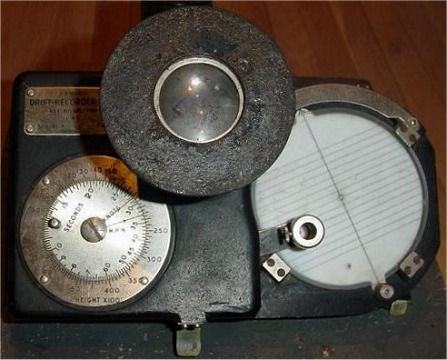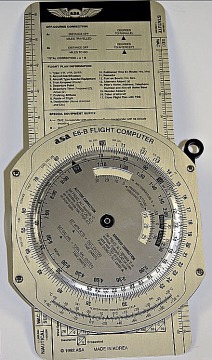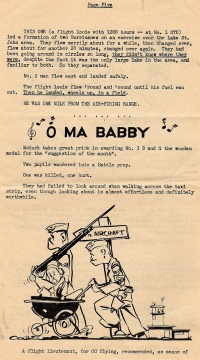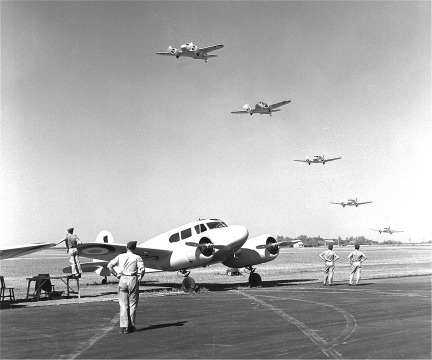AS YOU WERE . . .
WAR YEARS ECLECTICA :: August 2024
2024.08 Edition
|
celebrated Canada's 150th Birthday in 2017 by creating 150 illustrated vignettes for Brandon's BCATP Museum site. When the museum suddenly changed their Website all this work was trashed, along with all of my +20 years work (2,000 Webpages) created as a volunteer Webmaster and host for their site. Fortunately I had paid for all their Web hosting charges on my personal server, so I'm gradually giving the pages new life, but after having to change countless thousands of links. |
Canada 150 Vignette Series
British Commonwealth Air Training Plan Vignettes
PART XXVI: Nos. 126-130
By Greg Sigurdson/Bill Hillman
www.hillmanweb.com/150/26bcatp.htmlCONTENTS
126. Brothers two, dressed in blue, in World War II – Part 12
127. The Noorduyn Norseman
128. No. 5 Air Observer School – Winnipeg Manitoba
129. Mentioned in Dispatches
130. A World War II Memory: Cy Roberts, Flying InstructorContinued in PART XXVII: Nos. 131-135Many of the illustrations may be clicked for full screen size.
126 of 150: Brothers two, dressed in blue, in World War II – Part 12
During our time at Gransden someone made two changes, neither lasted more than a few days. They both looked good on paper but just did not work out. The first change was to have the W/T (Wireless Telegraphy) section have a member at debriefing to get a better understanding of the WAGs (Wireless Air Gunners) problems. This one died because after a long trip and operational debriefing it seemed silly to spend time doing what could be done as well the next day. The second change was to save manpower and dictated that aircrew WAGs do their own DI (definition unknown – sorry). This failed because the WAG arrived on the scene late in the afternoon when they had been on ops the night before. This meant that if they had a problem it left too little time to fix it. It meant we had to work harder but encouraged them to continue to DI but we also DI'd early in the day. Most of them stopped when they found we were continuing our efforts.Sam's anecdote... Finally, to have done with Track and Field, on July 15, 1943 five of us went from the squadron at Gransden to Digby to participate in a Six Group Field Day. I do not recall much about the specific events but I remember that only three of us ended up in the winner’s circle. I do however, vividly recall being summoned to the station commanders office a couple of weeks later to receive our medals. After having received them and having given the Group Captain our best shot at a salute, a procedure long forgotten, if we ever knew; and we were heading for the door when he said "Oh incidentally, you three men came within a point of bringing the cup back to your squadron". We should have tried a little harder.
I remember this event well because knowing it was scheduled I made an effort to get some track and field spike shoes. All my life I had competed in running shoes and been envious of those with spikes. Being a depression kid I had never owned a pair. I visited Cambridge on my day off and went to several shoe stores trying to convince them to let me have a pair of spikes without clothing coupons. My perseverance paid off because I found a store that let me have an unmatched pair of highjumping spikes with spike heels which I hacksawed off. I got them because one size 8 and one size 7 1/2. I wore one with a sock and one without. They helped me win two golds and a silver so my effort was worthwhile.
Something that did not bother me too much at the time but has occurred to me since was how come all our short stint stations such as Driffield, Topcliffe and Leeming were "brick" stations and our long period stations like Pocklington, was wood and Beaulieu And Grandsden were corrugated iron nissen huts. Now the part about being dispersed was OK but to have your bed in one building, the toilets in another and the showers in a third wasn't all that good on a cold rainy night. The showers were the worst. In Gransden we had a concrete building with no doors, just reverse entrances and while sometimes the water was warm the buildings had no heat. Getting dried and dressed after a shower was a real test on a cold winter day. Within an hours bike ride from our drome was a TB (tuberculosis) sanitarium at Papworth, I think. If these stories have a lot of I thinks in them remember there were no sign posts or maps available during the war and we were guided by landmarks. This community had a nice community hall and held dances each week. Many of the walking patients and nursing staff attended these dances which we learned about through Bill Keeler, one of our section members. Bill became friendly with the Edwards family who helped run the dances and we were often invited. The lunch at the dance was often water cress sandwiches made without margarine or butter. It was helpful in fuelling for the long ride home and was all the locals had to offer. I remember going to a dance at the nurses residence and seeing my first TV set. It had been decommissioned due to the war but sat there with its large eye staring at us. I think the only TV broadcasts in the world prior to the war were done from London and the location was close enough to pick up the signal.
In September 1943 I made a trip on leave to Northern Ireland to visit relatives. Sam had been before me and so my arrival was expected. My intention after a suitable visit was to rent civvies and proceed to Dublin for a repeat of good food and nylon stocking possibilities. The thought that I should wear rented clothes so bothered my Dad's cousin that she phoned a friend in the clothing business and arranged a suit and raincoat for me 'sans coupon'. I had this outfit which cost me six pounds for over a year and sold it for ten pounds when I returned to Canada. I remember the first time I wore it to London to visit Eve and she passed me by without a second glance although I stood where we always met when she came out from her work at the Ministry of Aircraft Production. It was fun being in civvies after all the years in uniform and I got a kick out of many looks which said "Why the hell aren't you in uniform?" from the people on busses and subway
The 1980 anecdote entitled "Movie Stars" can be supplemented by the since gained knowledge that the ship carrying the movie back to Canada was sunk. Part of the newspaper interviews survived.
During the fall of '43 the CBC or NFB, I don't recall which, sent a film crew and reporters to stage a "Xmas Dinner" at a Bomber base: I think about 40 of us were invited, 20 aircrew and 20 groundcrew. We were chosen on the basis of squadron seniority and a lot of "Rank" felt rank about the whole thing. It was held at the Legion in Gransden Lodge. The food was the best and drinks flowed freely.
The producer kept on insisting we sing "Good King Wenceslas" while the drink filled actors kept insisting they sing "Who'll come on ops in a Laney with me". John Fauquier made the decision and the latter prevailed.
Many of us were interviewed and after I got home the Jan. 18/44 article came into my possession. Prior to attending the Flag presentation ceremony at Greenwood I phoned the CBC to see if the film could be located. No luck.
Photo Credit - www.nissens.co.uk
127 of 150: The Noorduyn Norseman
Although it became one of Canada’s favourite aircraft, it found a limited role in the British Commonwealth Air Training Plan. Over a 24 year production period, more than 900 Noorduyn Norseman were produced by the Noorduyn Aircraft Company Ltd., Canada Car and Foundry Ltd. (1946) and a second version of the Noorduyn Aircraft Company (1952). The first Norseman was completed in November 1935. Of the 903 total made, 101 Norsemen were acquired by the Royal Canadian Air Force from 1935 to 1959. In actual fact, 79 were acquired by the RCAF and 21 went to the Royal Canadian Navy. Another two, bought from private owners, were added to the RCAF fleet. The RCAF’s initial order of 38 Norsemen Mk IV Ws were deployed to the BCATP where they were used at Navigation, Wireless and Bombing & Gunnery Schools in very limited numbers. When a second batch of 60 was added by the RCAF, Mk VI variants, their use became widespread among a number of domestic and overseas squadrons as transport for cargo and humans as well as in special assignments such as photo-reconnaissance.
The Royal Australian Air Force acquired 14 Norseman during World War II. This aircraft was very popular with the United States Army Air Force, especially in use in Alaska. Sixty-eight countries in the world have registered usage of the Norseman during and after World War II. It has also seen duty in the Arctic and Antarctic regions of the world.
Depending on configuration, the Norseman can be crewed by as little as one – a pilot. It has a capacity of 10 passengers. It is 32 feet long by 51 feet wide by 10 feet high. Initially the Norseman was powered by a Pratt and Whitney nine cylinder air-cooled radial piston engine with 600 horsepower. Subsequent variations were given more powerful engines. The Norseman can cruise at 150 mph, has a stall speed of 68 mph, a range of 932 miles and can fly up to 17000 feet. As a high wing monoplane, it gives easy access for cargo and passengers whether it is configured with fixed landing gears, floats or skis. It is economical to fly and superior in performance to its contemporaries.
A number of significant events are associated with the Noorduyn Norseman. Aircraft UC-64A, a Norsemen based in England, while in flight with pilot F/O John R.S. Morgan, was lost in the British Channel with Major Glenn Miller, the famous American band leader. Although never proven, two theories exist as to the circumstance of the demise of this aircraft, Morgan and Miller - carburetor icing or hits from bombs jettisoned by Royal Air Force Lancasters returning home from an aborted raid in Europe.
The first Norseman, sold to Dominion Skyways Ltd. in January 1936 and registered as CF-AYO, was leased in 1942 by Warner Brothers Studios to be used in filming aerial sequences for the movie Captains of the Clouds. It was lost in a crash in Algonquin National Park in 1952. The wreckage is now on display at the Canadian Bushplane Heritage Centre.
The most successful Canadian pilot during World War II, flying ace George "Buzz" Beurling was killed in a Norseman at the Urbe Airport in Rome, Italy in May 1948 while ferrying the aircraft to the Israeli Air Force.
https://en.wikipedia.org/wiki/Noorduyn_Norseman
128 of 150: No. 5 Air Observer School – Winnipeg Manitoba
Based in Winnipeg Manitoba, No. 5 Air Observer School was in operation for 1575 days between January 6, 1941 and April 30, 1945 at two locations on land which now is the home of the Richardson (Winnipeg) International Airport and RCAF 17 Wing. No. Built on 60 acres of Manitoba prairie, it is a mix of standard British Commonwealth Air Training Plan buildings – double-sized hangars, h-huts, administration buildings, messes and quarters for officer, airmen and non-commissioned officers, etc.. In its heyday, No. 5 AOS employed 900 civilians including ground crew, mechanics and pilots. Although No. 5 AOS was a privately owned school, operations were supervised by, and training was offered by Royal Canadian Air Force personnel.Utilizing ground school and airborne training with the Avro Anson aircraft, Air Observers (who were replaced by Navigators later in the war) underwent training which included navigation (dead-reckoning and visual navigation), wireless operation and bomb aiming. Training in navigational tools included aeronautical charts, the magnetic compass, time piece (watch), trip logs, the Douglas Protractor, Dalton Navigational Computer and the drift recorder.
In 1943 with an expansion of the number of trainees by three, No. 5 AOS was moved to new facilities nearby its original location. The abandoned school was taken over by No. 4 Wireless School. No. 8 Repair Depot, which employed 300 civilians, was also located nearby.
Sources:
Manitoba Historical Society - www.mhs.mb.ca/docs/sites/airobserversschool5.shtml

The drift recorder is used to measure direction and magnitude
of the effect of crosswinds on an aircraft’s course.
Dalton Navigational Computer
(Click for full size)
129 of 150: Mentioned in Dispatches
In Canada, a Mention in Dispatches is a recognition by a senior commander that a member of the armed forces, junior to that commander, deserves recognition for a brave and/or meritorious act. It is an award given by the Governor General on behalf of our monarch, as recommended by the commander. The award may include a tangible military honour such as a medal or bar for a medal, or it may simply be a written acknowledgement of the member and his or her act. A Mention in Dispatches is published in the Canada Gazette.With this in mind, this is why the attached pamphlet published by the Canadian Directorate of Air Training, Air Force Headquarters is confusing. It is entitled ``Mentioned in Dispatches’’ but doesn’t fulfill the objective of the definition outlined above. It is a collection of incidents, for July 1943, in which RCAF airmen acted stupidly on duty with the possibility of dire consequences for that action. Recipients in this case also, are not personally identified, but are given the title `student,’ `instructor’ or `staff pilot’ etc.
Most confusing of all is that the Directorate of Air Training would be allowed to satirize the otherwise sombre purpose of the 'real' Mentioned in Dispatches. Apparently there was no objection - this pamphlet is one of a dozen or so in the Commonwealth Air Training Plan archives for a number of months during World War II. As incredible as this document may be, it probably served a good purpose reminding readers of a multitude of situations to be avoided in order to avoid personal injury or death, and damage to equipment.
Enjoy – it is a humorous read with inside information about the intricacies of involvement with the British Commonwealth Air Training Plan.
.
.
.
.
.

.
.
.
..
.
130 of 150: A World War II Memory - Cy Roberts, Flying Instructor
In this Oral History, Cy Roberts submitted his recollections of three training incidents that occurred at No. 12 Service Flying Training School where he was a Royal Canadian Air Force instructor for the British Commonwealth Air Training Plan.Commonwealth Air Training Plan Museum 
A flight of Cessna Cranes flyover at opening day at
No. 12 Service Flying Training School, Brandon, Manitoba – DND photo.
Brandon Manitoba
Gentlemen (and Ladies)
The attached is submitted at the persistent and honorable request of the McNabb family of Minnedosa (Manitoba)! They are very much on your team – if not in fact – very much in spirit – and have been pressing for a contribution of some experiences occurring in the training of pilots at #12 (Service Flying Training School). The writer was fresh from F.I.S. (Flight Instructor School) to #12 December 12, 1942. He was to remain there exactly 2 years and one week – thereon being posted to Macdonald (No. 3 Bombing & Gunnery School) – as an instructor. He was to be involved with New Zealanders - Aussies – Canadians – some Brits – the lot – and as you can imagine – lots of different situations.
Your correspondent is C.M. Roberts, Toronto, Ontario.
This (now) old instructor had nearly finished his course at #2 F.I.S. Vulcan, Contact! – No. 1
"Who's got the reins?
Alberta. He doesn't know it yet- but shortly he'd be reporting to #12 S.F.T.S. F.I.S. has done a good job - taught their new instructors the correct and thorough way to teach their students. i.e. demonstrates, then explains precisely. The explanation is called PATTER. PATTER practice is obtained by flying with a classmate - and carefully instructing each other!In this particular case - he's in the front seat of a Cornell - hands folded – enjoying the day. He's had a good hour of practice - weather is beautiful - and they're going home!
Then gently - the aircraft dips to starboard - gently drops 4,500 feet – and gently rises to just about the original height - then if that isn't enough – it gently dips to port - drops another 4,500 feet and back where we started. It seemed ready to repeat again when this instructor says to his rear seat friend: "What the HECK are you doing?"
He gets a straight rather annoyed answer: "What do you mean - what am I doing?" "Aren't you flying this?"
"No aren't you?"
"No!"- We'd been pilotless!!!
Note: When you hand over control say loudly "You are in control"! The response is "I have control" It can head off a lot of problems.
WHEN REQUIRED ALL MY STUDENTS HEARD THAT STORY.
P/0 Roberts just posted to #12- reports to A flight Dec 1/42. Flight commander is FO Kjellander - an able individual who is a good friend to this day. Roberts is now ready for duty. Contact! – No. 2
What's a little Ice?Later in the day "Sky" Kjellander directs him to take a Crane to Chater (our relief field) about 10 minutes air time away - two of our students have had their a/c (aircraft) go US (unserviceable?).
Shortly, he's there and picks up New Zealanders Adolph and Sherrif (thank- you log book). Then airborne, and about five minutes later, their windscreen is suddenly coated with ice - totally! They have NO forward vision. Icing this severe can be bad news. The ice itself adds weight to the a/c and building up on the wing can actually change its shape and effectiveness.
The instructor knows he has to get down as soon as possible, he's peering out his side window with his students peering out theirs - he's careful to keep his sped 10-15 miles higher - and shortly notes the boundaries of #12 - he's 20-30' feet higher than normal - then suddenly WHAM! The alc just stopped flying and dropped heavily onto a gravel strip short of the paved runway. They're down and please to be in one piece!
Interesting note re: icing. Teaching the subject must come first in ground school and secondly of course from the flying instructor. When icing conditions do prevail at or near the station- the 0/C (officer in charge?) flying, using his own judgement plus consultation with his MET (meteorological) man - must either wash-out flying immediately - or specify dual only. Sometimes a critical, difficult but urgent decision.
In our case, seeing some other ice signs, and witnessing our difficulty flying was washed out immediately.
(Handwritten note – in flying at #12 for a couple of more years, we would experience other icing – but never again as sudden – or so heavy! C.R.)
Part and parcel of earning your wings at SFTS is training in night flying. When a student is ready for the night phase - he'll fly a number of night circuits with his instructor - then when considered ready, he'll be sent for several nights to fly these circuits solo. Confidence rising he'll then be slotted for a couple of night x-countries with his instructor. Contact! – No. 3
Follow the Leader!At this point in our story a new instructor has just been posted to #12 and assigned to "E" flight. After a few days getting acclimatized he is scheduled to take one of his four students on a 3-hour night x-country. It was at this point he asked his flight commander (self) if he could follow the F/C's aircraft for this trip.
As the territory was completely new to our new man, we agreed - instructing him to meet us at 6000 feet directly over the airport. He was to flash his lights for identification - and we would respond likewise.
He did - and we did - and we're off leading the way. The trip itself was uneventful - weather good - and about 3 hours later we're home. Our course had been triangular – Brandon - southeast then northeast - then home on the final leg.Anxious to hear how our new man had gotten along, we waited for his return in the flight room - and waited - and waited! After another half-hour we advised our station of our concern - then after another half-hour we alerted Command – our alc was missing!
Ten or fifteen minutes after that call - we received a call ourselves. It was our new instructor. Conversation went like this: Self " Man we're glad to hear your voice"
He "We're OK"
Self " Well where are your?"
He "We're in the States"
Self "in shock - in the States?" (couple of minutes later but barely composed- "How come you didn't follow us?’’
He "Well when you responded to our light flashing over the airport YOU LEFT your lights OFF - and we soon lost you’’
Later when he realized he was "good and lost" - he fired a flare from his a/c and saw what seemed to be a fairly flat, cropped farm field - it proved to be very, very fortunately adequate when one considers the soft spots and invisible holes that might have caught him.
You think that's the end- Wrong! It took about 3 days to get our new man, his student and the aircraft back to #12. During that time he had stayed with his aircraft, as he should - then when word got around the rural community, that a Canadian aircraft had made a forced landing at night in a local field - he and his student became celebrities!
Possessed of good looks and a good personality he proved to be an excellent ambassador. The kindly farm folk brought meals for both of them. The US government folks however, while co-operative and friendly took a poor view of foreign aircraft's "sneaking" into their country at night. They had strong objections at a similar event in daytime - but there's something sinister when this takes place at night.
Our "new instructor" and his student came back with a lot of stories - the main one however, was of a trip they'll never forget. Neither will their Flight Commander!
Continued in PART XXVII: Nos. 131-135
CANADA 150 Contents Page:
www.hillmanweb.com/150Contact Bill Hillman at:
hillmans@wcgwave.ca
www.hillmanweb.com
As You Were . . .
F.L.A.S.H.: Forces ~ Land ~ Air ~ Sea ~ Home
VISIT THE HILLMAN MILITARY TRIBUTES F.L.A.S.H.
As You Were . . .
Military TributesNavigation Chart to the
Hillman WWII Tributes
www.hillmanweb.com/warShort Bursts
Ex-Air Gunners Association
Magazines

Webmaster: William G. Hillman
BILL & SUE-ON HILLMAN ECLECTIC STUDIO
Editor and Webmaster Bill Hillman ~ Copyright 1999-2024